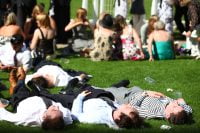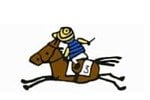[et_pb_section bb_built=”1″ admin_label=”section”][et_pb_row admin_label=”row”][et_pb_column type=”4_4″][et_pb_text admin_label=”Text” background_layout=”light” text_orientation=”left” use_border_color=”off” border_color=”#ffffff” border_style=”solid”]

Cockneys need not apply
We are used to Ascot, like all racecourses throughout Britain, being open and welcoming to all who are interested in the sport.
But the newspapers and journals of the 19th century felt no hesitation in registering their horror at the sight of the masses descending on genteel Ascot by way of the newly-extended railway line. Until then Ascot really had been regarded as the preserve of the nobility and gentry.
Pierce Egan, the leading reporter of sporting events of the early and mid-19th century, wrote that before the railways, Ascot had been protected from “the pollution of sheer cockneyism”. The Times complained that the railways had led to meetings where “attendance was immense, but…comprised perhaps an unusual number of that class of persons who are popularly denominated ‘roughs’.”
The Sporting Life was even more unashamedly snobbish, commenting that “the hilarious cockney is as much out of his element at Aristocratic Ascot as a duck on a turnpike lane.”
Who brought that horse in here?
Of course people still go to Royal Ascot today in their finery to see and be seen, but fashion was such a fundamental part of attending the Royal Meeting in the 19th and early 20th centuries that the “promenade” was almost an official part of the day. In 1823 The Times reported that “fashionable persons of both sexes promenaded up and down the course between the races.” But the state of the course was suffering as a result and so the fashion parade was moved to the Paddock.
For some, the parading of fashion remained infinitely more important than that of the horses. In 1912 their two worlds collided quite literally in the Paddock when a well-known actress’s bright red parasol caused a young racehorse to rear up. The actress leapt back, stabbing someone with the tip of her parasol. She exclaimed with genuine indignance and not a trace of irony, “It’s perfectly scandalous that horses should be allowed in here!”
Churchill takes the battle to the Royal Enclosure
King Edward VII (1901–1910) insisted that the Royal Enclosure be even more exclusive than under Queen Victoria and ruled that only those who had been presented at Court could be eligible for entry.
At that time Viscount Churchill was the King’s Representative at Ascot and had an extraordinary knack of remembering to whom he had sent a voucher. He personally selected those he deemed suitable for entry and was said to have three piles on his desk, labelled “certainly”, “perhaps” and “certainly not”.
Other rules for entry were quite incredible to our modern ears, such as that “no actor or actress should be eligible,” although The King himself bent this rule at his own discretion. Even more extraordinary was that divorcees, male or female, were barred from entry to the enclosure until 1955.
War horses take time to recover
Ascot suspended racing during the Second World War, but most people are not aware that the war had longer term repercussions on the sport. Although horse racing enjoyed a post war boom, it was certainly not boom-time for the British racehorse owner.
In 1946, the first year that racing resumed at Ascot, French horses took the first three places in The Gold Cup and, in fact, won much of the racing that year due largely to having been better fed in occupied France than in rationed Britain.
Gentlemen put to work in the Royal Enclosure
These days there is only one real regulation for women in the Royal Enclosure, that they wear formal day dress with a hat. But as late as the 1920s they also had to stick to a number of “unwritten rules” that if broken might bring disrepute on themselves or their husbands or chaperones.
One was that women should not have direct contact with bookmakers, and so their poor male companions were constantly being interrupted to be sent on errands between races to place bets on their behalf.
Another archaic rule, enforced by the notoriously fastidious Clerk of the Course Colonel Sir Gordon Carter in 1922, was that women could not smoke in the Royal Enclosure.
| DID YOU KNOW? Ascot Racecourse runs a FREE club called Colts & Fillies for children aged 16 and under. |
[/et_pb_text][/et_pb_column][/et_pb_row][/et_pb_section]
Allison is the Publisher of Eclipse Magazine. She loves going to the Races and is learning to bet (despite being officially the worst bettor in the History of the Universe), there’s a lot more to learn…



